Organization
- Reconnaissance
2nd Northhamptonshire Yeomanry, then 15 / 19th King’s Royal Hussars - 29th armoured brigade
23rd Hussars
3rd Royal Tank regiment
2nd Fife and Forfar Yeomanry
8th Rifle brigade - 159th infantry brigade
3rd Monmouthshire regiment
4th King’s Shropshire light infantry
1st Herefordshire regiment - Support
The Northumberland Fusiliers - Artillery
13th horse artillery regiment (self-propelled)
151st field artillery regiment (towed)
75th anti-tank regiment
58th light anti-aircraft regiment - Engineers
- Signals
- Services
History
Sign of the Bull
The creation of the 11th division was the British answer to the success of German panzer divisions in the previous years. In Poland in 1939 then in Western Europe in 1940, they had clearly displayed new tactics and methods of fighting, and the United Kingdom had to face them.
Creation of the 11th armoured division was ordered in March 1941. Organization and training originaly started in Yorkshire. The lead of the young division was first entrusted to gen. Percy Hobart. Veteran of the armoured Corps, he had already strongly influed the shape of the 7th AD, but his original and innovative ideas had granted him to be fired from the army. Reinstated after the disasters of 1940, he could at least enforce his vision with the 11th AD, which took profit thus of his long experience of armoured warfare. Under his inspiration division adopted the “Charging Bull” as emblem. From 1942 on, it began an intensive training while gradually receiving new, modern. equipen
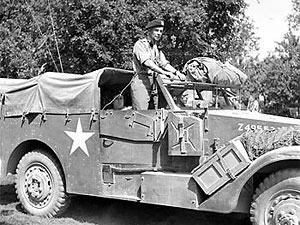
Year 1943 saw an acceleration of the preparations linked to the plans for invasion in Europe. First of all, Hobart was replaced by George Philip “Pip” Roberts, youngest general of the British army, who was to lead it to the fight. In May, 11th AD perceived its final equipment, the Sherman and Cromwell tanks, which will be the spearhead of British armoured divisions. After three years of training, it was selected to take part in the invasion of northwestern Europe.
In Normandy
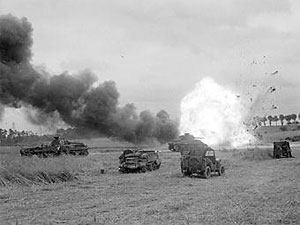
11th AD landed on Juno Beach June 13th. It was to be employed in all major operations of the 21st Army Group – Epsom, Goodwood, Bluecoat, and Falaise gap.
The 11th AD was committed June 27th in the Odon river sector, for taking action in operation Epsom. It engulfed in the “Scottish corridor” beforehand opened by the 15th infantry division, and, despite navigation mistakes which slowed down the 159th brigade in Mouen, it managed to seize the bridges at Grainville and Colleville. It progressed then southward to coast 112 and succeeded in capturing then holding this high ground against increasing violence of German counter-attacks. However, renewed attack of fresh SS-Panzerdivisions called from reserve transformed what was supposed to be a breakthrough into a position war. On June 30th, Dempsey, commanding the 2nd British army, fearing a general counter-offensive, ordered the 11th AD to withdraw from coast 112. Epsom failed…
The 11th AD was then moved east of Caen, to spearhead the Goodwood operation. The objective of this drive was to circumvent the city from the eastern side and to break towards Falaise. 11th AD sprang early in the morning of July 18th, and carried out a remarkable progression. Unfortunately, German resistance hardened strongly as the division ran deeper into german-held positions. Losses increased even more during the afternoon, when Taurus Pursuant was found blocked on the Bourguebus ridge. It managed to seize the following day the strongly defended villages of Soliers and Hubert-Folie, but the momentum was definitively lost. Goodwood was cancelled July 20th, with 11th AD being withdrawn from the frontline to rest and refit. In this two-days fighting, it had lost 200 tanks, more than half of its dotation…

B-9329

Because of suffered casualties, 11th AD had to be reorganized. The 23rd Hussars absorbed the remainders of the 24th Lancers (8th brigade), then the 11th dB was once again directed to the west, to take part in “Bluecoat”. Starting to attack on July 30th, it progressed quickly towards the south, seized Martin-Saint-des-Besaces then spotted an intact bridge on Souleuvre river, which enabled it to drive to the Germans backs. It was then th famous “charge of the bull”: the division liberated Le Bény-Bocage on August 1st, then progressed quickly southward. Although severly weakened at that time, enemy remained present and dangerous: along with units of Guards AD and 15th ID, Taurus had to push back a counter-attack of 9th SS-PzD from August 5th. Two days later, around Chênedollé, one single Tiger managed to destroy 14 tanks of the 23rd Hussars…
After being replaced by the 3rd ID, the 11th AD was attached to the 30th Corps. It progressed eastward, on the heels of the Germans who were retreating after the failure of the Mortain counterstroke. The Charging Bull division seized Flers on August 17, then moved on Putanges. From August 19th on, it pushed the Germans back north of Argentan; it captured the commander of German 276. ID, gen. Badinski, and more than 900 prisoners.
Once finished the fight of the Falaise gap, 11th AD liberated L’Aigle August 23, then crossed the Seine August 28th.
Belgium and Netherlands
After his participation in the last stage of Normandy campaign, 11th armoured division performed again the “charge of the bull”: after a night ride, it liberated Amiens September 1st. The same day, it captured gen. Eberbach, commander of the 7. German army. Progressing by Lens, then Tournai, division was then committed in the fight for Antwerp, which it liberated on September 4th. Two days later, it tried to establish a bridgehead on the Albert channel, but the attempt failed in nintense ennemy fire. After this faillure, 11th AD had to cross much more to the east, at Beeringen. It advanced then by Helchteren, Peer, Bree, and cleaned the area between the Albert channel and the Maas up to September 12. The Taurus Pursuant was then put at rest for one week.

11th AD was not directly committed in Market – Garden. Instead, it was in charge of securizing the rignt flank of the operation. Attached to the 8th Corps, it was put moving on September 18. Progressing in two columns, it managed to reach the parachutists of the 101st airborne at Nuenen, while the 22, its engineers established a bridge on the Willemsvaart canal. Division could then make an encircling movement around Helmond, forcing Germans to withdraw September 25.
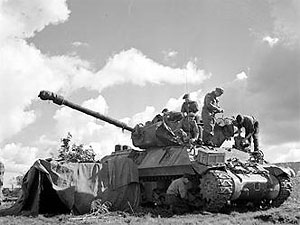
At the beginning of October, the 11th AD was employed to clean pockets of German resistance remaining west of the Maas. The operation developped promisingly with 159th brigade battling its way across Deurne canal. Unfortunately, the attack was quickly stopped by obstinate German resistance. In addition to the growing supply shortage and the launching of an enemy counter-attack more in the south, this skillfull defence postponed cleaning of the Mass for several weeks.
Preparations for a new crossing attempt were delayed until second half of following month. November 22nd, 159th brigade managed to cross and to seize the village of America. It progressed by Horst, before being released by the Scots of the 15th ID. November 30, it attacked the fortress of Broekhuizen, defended by german parachutists. Enemy inflicted heavy losses, before capitulating on December 5th. On this date, the Western bank of the Maas was cleared.
From Ardennes to the Rhine
At the beginning of December, units which composed the 11th AD were redirected towards Ypres. Infantry was to benefit from a longer rest, while tank crews would receive new Comet tanks, at least able to engage german panzers at comfortable range.
The start of the Ardennes offensive modified british projects. Being one of the too rare units in reserve, the 11th AD was urgently recalled to active and received mission to hold a defensive line along the Meuse, between Namur and Givet. On December 24th, its advanced positions spotted and destroyed several tanks of the 2. PzD east of Dinant. From December 26th on, Germans started to withdraw and 11th AD was replaced by the 6th airborne, after having pushed the ennemy back beyond Celles. Only 29th brigade was maintained in support of the parachutists. It rejected the Germans back to La Bure and Wavreille between January 3rd and January 7th. From the 9th on, it reached Grupont, before being finally directed the following day to Ypres for rest, refit and train activities.

It is no sooner than February 17th, 1945 that the 159th brigade was recalled to the front, to add its weight to the allied forces committed in the Rhineland. The infantry of the 11th AD received mission to seize Gochfortzberg, south of Udem, then to break the Schlieffen line and to capture Sonsbeck, in order to support the 2nd Canadian Corps which progressed towards Hochwald from the north. Attack of the brigade started February 26th. Under challenging conditions, the brigade seized Gochfortzberg February 28th, then approached Sonsbeck on March 3rd.
In Germany
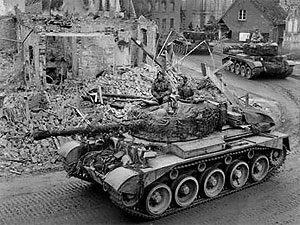
The 11th AD was held in reserve until March 28th. On this date, it crossed the Rhine at Wesel, in direction of the mouth of Weser. Progressing quickly in spite of sporadic pockets of resistance, it reached Gescher March 30th, in the evening. The following day, 3rd RTR arrived on Ems river in Emsdetten, before crossing and reaching the Dortmund-Ems canal the following day.
After crossing the Dortmund-Ems canal on April 1st, the 11th AD approached Ibbenburen and was heavily engaged on the heights of Teutoburger Wald. Villages Brochterbeck or Tecklenberg were captured at high price. More in the east, the wooden hills were defended by companies of NCOs, who savagely counter-attacked the 3rd Monmouthshire. Later on, intervention of the 131st infantry brigade (7th armoured division) will make it possible to overcome their opposition, but 3rd Monmouthshire, already weakened during previous campaigns, will have to be replaced by 1st Cheshire…
11th AD continued toward the canal of Osnabruck. After having it crossed on a captured bridge, it moved towards Weser, reached by leading elements near Stolzenau on April 5th. One week later, the 11th AD liberated the concentration camp of Bergen-Belsen. A local agreement with German commanders made it possible to declare the neighbourhoods of the camp open area, and the fighting moved northeast. Progressing towards Elba, the 11th AD was the first British unit to reach this river in the neighboorhood of Luneburg the 18th.
It is only on April 30th that the 11th AD was launched in a last attack. It crossed Elba in Arlenburg, then, practically without meeting opposition, occupied Lübeck on May 2nd. It finished the war by patrolling the surroundings, and collecting 80.000 prisoners including 27 Generals. It is there that the capitulation of Germany put an end to its triumphal walk.
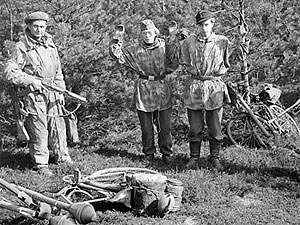

After the end of the war, Taurus Pursuant was used as occupation force in the Schleswig-Holstein. On May 23, it was employed to capture members of the Dönitz government in Flensburg.
11th armoured division was dissolved end of January, 1946. During the campaign in northwestern Europe, its losses rose to 1.820 killed and more than 8.000 wounded. Its rotation in tanks was 300%, the record pertaining to the major Close (3rd RTR), which lost eleven but survived each time.










